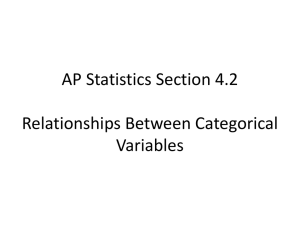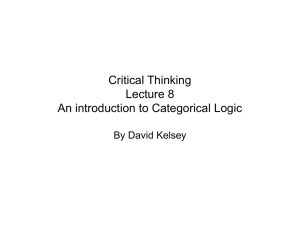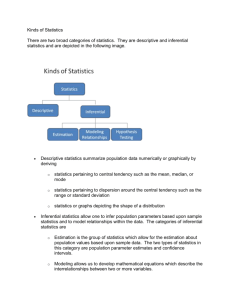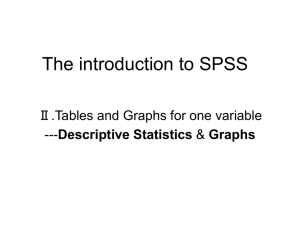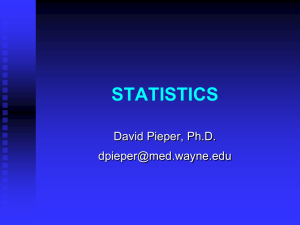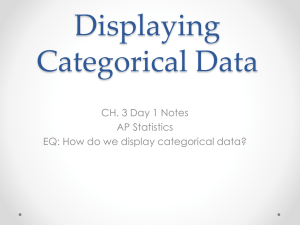Is There More than One Categorical Property?
advertisement
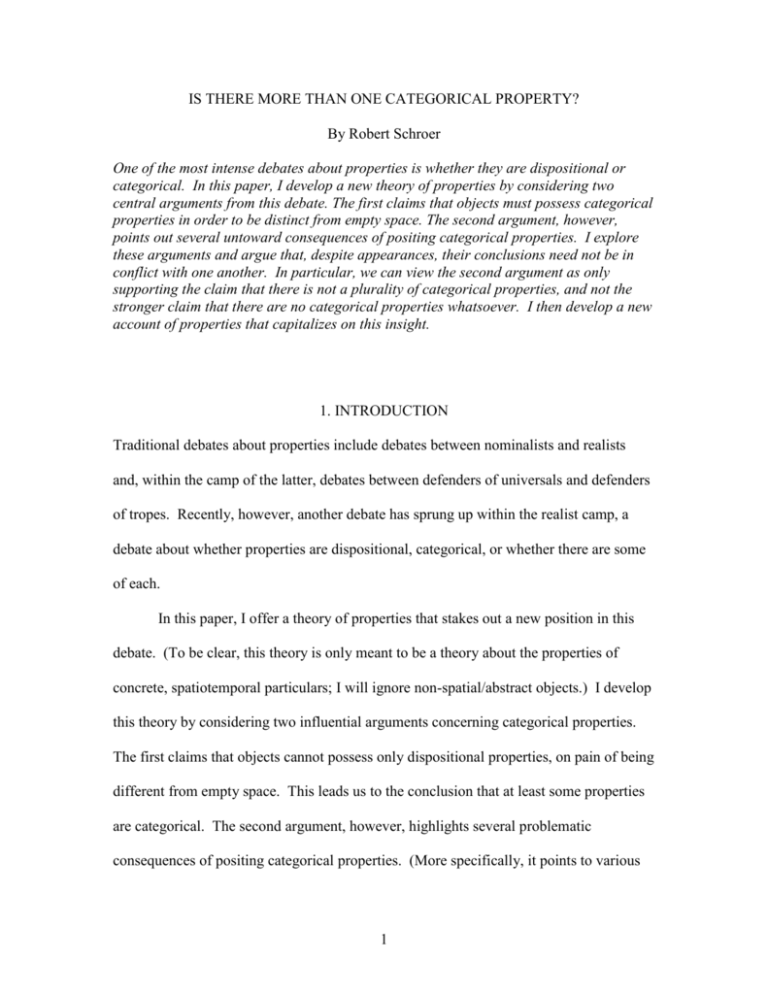
IS THERE MORE THAN ONE CATEGORICAL PROPERTY? By Robert Schroer One of the most intense debates about properties is whether they are dispositional or categorical. In this paper, I develop a new theory of properties by considering two central arguments from this debate. The first claims that objects must possess categorical properties in order to be distinct from empty space. The second argument, however, points out several untoward consequences of positing categorical properties. I explore these arguments and argue that, despite appearances, their conclusions need not be in conflict with one another. In particular, we can view the second argument as only supporting the claim that there is not a plurality of categorical properties, and not the stronger claim that there are no categorical properties whatsoever. I then develop a new account of properties that capitalizes on this insight. 1. INTRODUCTION Traditional debates about properties include debates between nominalists and realists and, within the camp of the latter, debates between defenders of universals and defenders of tropes. Recently, however, another debate has sprung up within the realist camp, a debate about whether properties are dispositional, categorical, or whether there are some of each. In this paper, I offer a theory of properties that stakes out a new position in this debate. (To be clear, this theory is only meant to be a theory about the properties of concrete, spatiotemporal particulars; I will ignore non-spatial/abstract objects.) I develop this theory by considering two influential arguments concerning categorical properties. The first claims that objects cannot possess only dispositional properties, on pain of being different from empty space. This leads us to the conclusion that at least some properties are categorical. The second argument, however, highlights several problematic consequences of positing categorical properties. (More specifically, it points to various 1 problems that arise from positing that a given property is only contingently connected to the powers it conveys to its bearers.) The conclusion of this argument is that no properties are categorical. These two arguments create a tension concerning the status of categorical properties: The first says that we need them to distinguish objects from empty space, but the second says that they create too many problems to be worth their weight. When faced with this dilemma, most people will accept one of these arguments while biting the bullet on the other. I will argue, however, that it is possible to accept both arguments. The key to pulling this off is to reconsider the sense in which properties are categorical. Traditionally, defenders of categorical properties maintain that: 1) properties that are categorical are entirely categorical—their essence is exhausted by their categorical nature, and 2) the set of categorical properties contains variety—there is a “plurality” of (determinate) categorical properties where each of these properties contributes a different categoricity to its bearers. I break with tradition in both respects. To start with, I will argue that we can interpret the second argument as showing that there is no variety within the set of categorical properties—various tokens of categorical properties all contribute the same (determinate) categoricity to their bearers. The claim that there is a single categorical property, a property that distinguishes every object from empty space, however, is disturbing close to the vilified claim that existence is a property. I avoid this concern by claiming that every property is both dispositional and categorical. This ensures that an instantiated property will do more than simply distinguish its bearer from empty space—it will also impart it with some dispositionality. 2 2. DISPOSITIONAL AND CATEGORICAL PROPERTIES To borrow the words of Nelson Goodman, a dispositional property is a property that is “full of threats and promises.”1 Dispositional properties point beyond whatever object they are instantiated in to possible manifestations or causal interactions with other objects, manifestations/causal interactions that may not be occurring and that, in fact, may never occur. I will assume that the dispositional properties of an object are intrinsic properties of that object, properties that are “really there” and “ready to go” in the object even if the manifestations/causal interactions that they point to are not presently occurring.2 As I use the term, there is a necessary connection between a “dispositional property” and the powers it conveys to its bearer. (The “powers” that a dispositional property conveys to its bearer are powers to make it act in various ways in various circumstances.) More specifically, the powers conveyed by a given dispositional property exhaust the essence of that property. Categorical properties, in turn, are defined negatively; the essence of a categorical property is not connected to how it makes its bearer behave in various circumstances or causally interact with other objects. Rather, a categorical property just sort of sits there, 1 N. Goodman, Fact, Fiction, and Forecast, 2nd edition (Indianapolis: Bobbs-Merrill, 1965), p. 40. 2 The claim that dispositional properties are intrinsic properties is widely accepted; see, for example, C.B. Martin, ‘Dispositions and Conditionals’, Philosophical Quarterly, 44 (1994), pp. 1-8; J. Heil, From an Ontological Point of View (New York: Oxford University Press, 2003); J. Heil, ‘Dispositions’, Synthese, 144 (2005), pp. 343-356; G. Molnar, Powers: A Study in Metaphysics (Oxford: Oxford University Press, 2003); A. Bird, Nature’s Metaphysics (Oxford: Oxford University Press, 2007). 3 constantly exhibiting its nature.3 If a categorical property conveys a set of powers in this world (in concert with the laws of nature), there is no guarantee that it will convey those same powers in a different world that is governed by different laws of nature.4 For this reason, the Categoricalist view of properties is sometimes described as “quidditism”; like haecceitism, which posits that individuals have a transworld identity that does not depend upon their qualitative features, quidditism is the position that properties have a transworld identity that does not depend upon their causal powers.5 Some philosophers, I’ll call them “Dispositionalists”, think all properties are dispositional properties (as I have defined that notion above).6 “Categoricalists”, in contrast, think all properties are categorical.7 “Pluralists”, in turn, maintain that there are both dispositional properties and categorical properties.8 Finally, and considerably less Some prefer to call categorical properties “qualitative properties”, for drawing the contrast in the former way might be taken to suggest that dispositional properties are not “really there” in the object when their manifestations are not occurring. See, for example, C.B. Martin, ‘On the Need for Properties: The Road to Pythagoreanism and Back’, Synthese, 112 (1997), pp. 193-231; G. Molnar, Powers; and J. Heil, From an Ontological Point of View. 4 As Schaffer explains, the defender of categorical properties could maintain that the laws of nature are necessary and, hence, constant across all possible worlds. (See J. Schaffer, ‘Quiddistic Knowledge’, Philosophical Studies, 123 (2005), pp. 1-32.) Under such a theory, categorical properties would end up conveying the same powers to their bearers in all possible worlds. I ignore this complication in what follows. 5 For further discussion of quidditism, see R. Black, ‘Against Quidditism’, Australasian Journal of Philosophy, 78 (2000), pp. 87-104; J. Schaffer, ‘Quiddistic Knowledge’; A. Bird, Nature’s Metaphysics. 6 See, for example, S. Shoemaker, ‘Causality and Properties’, in P. van Inwagen (ed.), Time and Cause (Dordrecht: Reidel Publishing Company, 1980), pp. 109-135; S. Shoemaker, ‘Causal and Metaphysical Necessity’, Pacific Philosophical Quarterly, 79 (1998), pp. 59-77; A. Bird, Nature’s Metaphysics. 7 See, for example, D.M. Armstrong, A World of States of Affairs (Cambridge: Cambridge University Press, 1997). 8 Given that categorical properties have been defined negatively, a Pluralist would be someone who thinks that there are both dispositional properties and non-dispositional 3 4 popular, is the position that maintains that every property is both dispositional and categorical.9 Let’s explore the Categoricalist and Dispositionalist positions in a little more detail. Typically, Categoricalists do not deny that, say, solubility is a genuine property; rather, they reduce solubility to a categorical property (and perhaps the laws of nature). To avoid confusion on this score, I’ll say that Categoricalists countenance “dispositionallike properties” (where such properties are ultimately reduced to categorical properties). Both dispositional and dispositional-like properties point beyond themselves to possible manifestations or causal interactions with other objects; the difference is that there is a necessary connection between a dispositional property and the powers it conveys to its bearers, while there is only a contingent connection between a dispositional-like property and the powers it conveys. Dispositionalists, in contrast, tend to be eliminativists, not reductionists, about “categorical-like properties”.10 There is a lively debate between Dispositionalists and Categoricalists. In the next two sections, I will examine two influential arguments from these debates: This first claims that there is something troubling about the idea that objects possess only dispositional properties. The second, in contrast, raises doubts about properties that are only contingently connected to the powers they bestow upon their bearers. properties. For example, see G. Molnar, Powers and B. Ellis, Scientific Essentialism (Cambridge: Cambridge University Press, 2001). 9 This position is held by C.B. Martin, ‘On the Need for Properties’ and J. Heil, From an Ontological Point of View, ‘Dispositions’, and ‘Review of Peter Unger, All the Power in the World’, Nous, 42 (2008), pp. 336-348. 10 For more about describing these positions in the language of reductionism, eliminativism, etc., see S. Mumford, Dispositions (Oxford: Oxford University Press, 1998). 5 3. THE FIRST ARGUMENT: COULD THERE BE OBJECTS THAT POSSESS ONLY DISPOSITIONAL PROPERTIES? Many have thought that the idea of a world consisting of objects with nothing but dispositional properties is difficult to conceive of, if not outright incoherent.11 But what, exactly, is the problem with such a world?12 Does the absence of categorical properties make such objects unknowable? Does it make it impossible to give a non-circular definition of the dispositional properties of such objects? I will interpret the “world of pure powers” objection in the following way: If objects did not have categorical properties in addition to having dispositional properties, then there would be nothing there to affect other things or be affected by other things. Consider, in particular, a world of objects that have only dispositional properties where none of those properties are active (i.e. the manifestations/causal interactions that the properties point to are not occurring); it is difficult to grasp the difference between such a world and a world of empty space.13 Let’s explore this concern in more detail. I have claimed that dispositional properties are intrinsic properties. This means that an object can still possess dispositional properties even when those properties are dormant. So the problem with an 11 See, for example, K. Campbell, Metaphysics: An Introduction (Encino, Calif: Dickenson Publishing Company, 1976); D.M. Armstrong, A World of States of Affairs; C.B. Martin, ‘On the Need for Properties’; J. Heil, From an Ontological Point of View. 12 For catalogues of some of the interpretations of this objection, see G. Molnar, Powers and A. Bird, Nature’s Metaphysics. 13 Several others have also framed their complaint against Dispositionalism by challenging the defender of that position to describe the difference between objects that possess only dispositional properties and empty space. See, for example, S. Blackburn, ‘Filling in Space’, Analysis, 50 (1990), pp. 62-65 and P. Unger, All the Power in the World (Oxford: Oxford University Press, 2006). This, of course, is an echo of a much earlier argument, given by Hume and Berkeley, that the primary qualities, by themselves, are not enough to “fill in” space. 6 object that possesses only dormant dispositional properties is not that it is property-less. Rather, the problem is that, when they are dormant, these properties are not actively contributing anything to that object that would distinguish it from empty space. Solubility, for example, makes a piece of salt different from empty space when that salt is dissolving in water. But when the solubility of a piece of salt is dormant—i.e. when it is not in water—this property is not actively contributing anything to the salt that distinguishes it from empty space. So if there were a period of time where all the properties of an object were dormant dispositional properties, it’s hard to see how that object would be different from empty space. A categorical property, in contrast, makes a contribution to its bearer that is independent of any external circumstances or causal interactions with other objects; a categorical property makes an active contribution to its bearer regardless of the circumstances it is in and the causal interactions it is involved with. So even when the object in question is not in the relevant circumstances or interacting with the relevant objects, its categorical properties are still making an active contribution to it and, hence, distinguishing it from empty space. The conclusion of the First Argument, then, is that at least some properties of our world are categorical properties; more specifically, the conclusion is that at least some properties make an active contribution to their bearers independent of the circumstances they are in or the causal interactions they are involved with. 4. THE SECOND ARGUMENT: PROBLEMS WITH PROPERTIES THAT CONTINGENTLY BESTOW POWERS UPON THEIR BEARERS 7 There is a contingent connection between a given categorical property and the powers it conveys. (To be clear, the defender of categorical properties could maintain that categorical properties contribute no powers to their bearers. I will ignore this possibility in what follows; I am working with the typical Categoricalist position, a position that posits dispositional-like properties.) This contingent connection, in turn, has generated a hodgepodge of objections against categorical properties. In what follows, I will identify two of the more serious of these objections. First, if we assume that properties are transworld entities, then the categorical property that confers the powers associated with, say, mass in the actual world could confer the powers associated with charge in another world. But can we really understand the sense in which a categorical property in another possible world is supposed be mass if it acts just as charge acts in this world?14 Second, if the essence of categorical properties is disconnected from the powers they confer, then there could be two distinct categorical properties in the actual world that convey exactly same set of powers. But how could we tell whether this possibility obtains? By hypothesis, these categorical properties are guaranteed to affect any instrument (including us) in exactly the same way. This means that we are destined to be unable to tell whether all electrons have the same charge in virtue of having the same categorical property or whether some of them have that charge in virtue of having one categorical property while others have it in virtue of having a completely distinct categorical property. Furthermore, to borrow an example from Sydney Shoemaker, we For more detailed discussion of this claim, see S. Shoemaker, ‘Causality and Properties’ and A. Bird, Nature’s Metaphysics. Bird supplements this argument against categorical properties by comparing it to Chisholm’s argument against haecceitism. (See R. Chisholm, ‘Identity Through Possible Worlds’, Nous, 1 (1967), pp. 1-8.) 14 8 are destined to be unable to tell whether a single object retained the same categorical property over time or whether it underwent a change where one categorical property was replaced by another one that happens to convey the same powers.15 In summary, a position that posits categorical properties—more specifically, a position that reduces dispositional-like properties to categorical properties—creates questions that it cannot answer.16 5. A MIDDLE GROUND The previous arguments seem to place us between a rock and a hard place: The first pushes us to posit that at least some properties are categorical properties and, as a result, attacks the Dispositionalist. The second, however, pushes us to posit that all properties are dispositional and, as a result, attacks the Categoricalist. (The second argument also attacks the Pluralist if he or she posits dispositional-like properties.) It’s difficult to tell which bullet to bite when faced with this dilemma: Should we claim that all properties are dispositional and admit that we can’t explain the difference between an object that has dormant dispositional properties and empty space? Or should we claim that there are some categorical properties and admit that the existence of these properties raises questions that cannot be answered? S. Shoemaker, ‘Causality and Properties’. The claim that there could be two distinct categorical properties that are guaranteed to affect any instrument in the same way is sometimes used as a premise in arguments that conclude that it is impossible for us to refer to or know about categorical properties. (See, for example, S. Shoemaker, ‘Causality and Properties’ and ‘Causal and Metaphysical Necessity’; F. Jackson, From Metaphysics to Ethics (New York: Oxford University Press, 1998); S. Mumford, Laws in Nature (London: Routledge, 2004); A. Bird, Nature’s Metaphysics.) My point is that the starting point of these arguments is bad enough to serve as an objection to categorical properties all on its own. 15 16 9 Perhaps we don’t have to choose. There is a middle ground, a way of reading the conclusions of the above arguments so that they are not incompatible with one another. The conclusions of these arguments appear incompatible because when we conclude, in line with the First Argument, that there are at least some categorical properties, we automatically assume that there is a plurality of categorical properties. (By a “plurality” of categorical properties, I mean that there are a variety of (determinate) categorical properties—i.e. there are many determinate ways of being categorical.) The idea that there is a plurality of categorical properties, in turn, leads to the worrisome possibilities discussed in the Second Argument. But there is nothing in the First Argument that calls for a plurality of categorical properties. Positing that that every object in space-time instantiates the same (determinate) categorical property is sufficient to sidestep the worry about a world containing objects that possess only dispositional properties. For when their dispositional properties are dormant this categorical property will still actively contribute something to the objects that instantiate it and that, in turn, makes those objects different from empty space. Now let’s turn to the Second Argument. If there is a plurality of categorical properties, where one of these properties is contingently associated with the powers of mass and another is contingently associated with the powers of charge, then in another possible world these associations could be inverted. Similarly, there could be two distinct categorical properties in the actual world that happen to convey the same powers. But if we deny that that there is a plurality of categorical properties—if we instead claim 10 that all categorical properties contribute the same determinate categoricity to their bearers—then neither of these worrisome cases can arise. The idea that there is only one determinate categorical property may strike you as off-putting. As have seen, however, there is nothing in the First Argument that forces us to claim that there is a plurality of categorical properties. Are there other reasons, reasons independent of the First Argument, for thinking that categorical properties form a plurality? 6. THE CASE IN FAVOR OF A PLURALITY OF CATEGORICAL PROPERTIES Let’s assume, for sake of argument, that there are categorical properties. In this section, I will examine and evaluate the case for thinking that these categorical properties form a plurality. 6.A.) The plurality of dispositional-like properties requires a plurality of categorical properties The dispositionalities of objects come in a variety of types: objects can be malleable, soluble, magnetic, etc. Given the right theoretical assumptions, this plurality of dispositionalities could be a reason for believing in a plurality of categorical properties. In particular, if you are a Categoricalist who thinks that the dispositionalities of objects is the result of their having dispositional-like properties, you will need to posit a plurality of categorical properties to reduce these properties to. After all, solubility and malleability can’t be reduced to the same categorical property! 11 This argument in favor of a plurality of categorical properties relies on the controversial assumption that the dispositionalities of objects are a result of their possessing dispositional-like properties. As we have seen, the Second Argument gives us reason to be suspicious of dispositional-like properties. If, in contrast, you believe that objects are dispositional in virtue of possessing dispositional properties, then the worries raised by the Second Argument dissolve. Similarly, if you believe that objects are dispositional in virtue of possessing dispositional properties, the above argument in favor of a plurality of categorical properties also dissolves. For dispositional properties are irreducibly dispositional—their dispositionality is not the result of categorical properties and the laws of nature. So the fact that there is a plurality of dispositional properties is no reason to think that there must also be a plurality of categorical properties. Here’s another way to put the point: For a typical Categoricalist, categorical properties have two jobs to do: 1) They explain the difference between an object whose dispositional properties are all dormant and empty space, and 2) they account for the variety of dispositional-like properties of objects. But if we account for the dispositionalities of objects by positing dispositional properties in place of dispositionallike properties, then the only job left for categorical properties is the first job. And, as we have seen, we do not need to posit a plurality of categorical properties to accomplish that job. 6.B.) Without a plurality of categorical properties, there would be a regress of powers 12 Earlier, I read the “world of pure powers” objection as showing that we need categorical properties in order to distinguish objects with dormant dispositional properties from empty space. There is another way of reading this objection, however, that supports the claim that categorical properties form a plurality.17 If dispositional properties are individuated in terms of their relations to various stimuli and manifestation conditions, and these stimuli and manifestation conditions, in turn, are individuated in terms of their relations to other stimuli and manifestation conditions, and so on, then it appears that the identity conditions for any given dispositional property will involve a problematic regress and, as a result, cannot be fixed. The way out of this regress is to posit that dispositional properties are powers to bring about both dispositional and categorical changes. And in order for there to be categorical changes, there must be categorical diversity—there must be a plurality of categorical properties. The issues raised by this argument are complex and fully evaluating them is beyond the scope of this paper.18 But it is worth noting that the claim that Dispositionalism leads to a problematic regress with respect to the identity conditions of properties is controversial. Alexander Bird, for instance, models the identity conditions of dispositional properties using graph theory and then shows that, under this model, there is no problematic regress involving the identity conditions of those properties.19 For what it’s worth, I’m inclined to agree with Bird on this score. As I see it, the real problem presented by the “world of pure powers” objection is not that we can’t give fully 17 I am indebted to an anonymous referee for pointing out this argument. For a sample of the debate here, see R. Dipert, ‘The Mathematical Structure of the World’, Journal of Philosophy, 94 (1997), pp. 329-358; J. Heil, From an Ontological Point of View; A. Bird, Nature’s Metaphysics. 19 A. Bird, Nature’s Metaphysics, Ch. 6. 18 13 determinate identity conditions for dispositional properties; rather, it’s that we can’t distinguish objects that only possess dormant dispositional properties from empty space. 6.C.) The perceptual argument for a plurality of categorical properties Another reason for believing in a plurality of categorical properties is that we can see that these properties admit of diversity. This simple argument, however, does not sit comfortably with the widespread commitment in contemporary metaphysics to a “sparse” conception of properties.20 Under an “abundant” conception of properties, every intelligible predicate corresponds to a property. So, for example, “not golden”, “first examined before 2000 A.D.”, and “owned by Fred” all express genuine properties.21 Under a “sparse” conception, in contrast, every intelligible predicate does not correspond to a property; rather, the class of genuine properties is limited to just those that are necessary to provide “a minimal basis for characterising the world completely”.22 Under such an account, non-fundamental properties are recast as being nothing more than complexes (or conjunctions) of simpler, more fundamental properties; in short, nonfundamental properties are no addition of being. The tension between adopting a sparse conception of properties and claiming that we can see categorical properties is explained by George Molnar— This is David Lewis’ terminology. Advocates of a sparse conception of properties include D. Lewis, ‘New Work for a Theory of Universals’, reprinted in his Papers in Metaphysics and Epistemology (Cambridge: Cambridge University Press, 1997), pp. 855; D.M. Armstrong, A World of States of Affairs; J. Heil, From an Ontological Point of View; G. Molnar, Powers; A, Bird, Nature’s Metaphysics. 21 All these examples are taken from D. Lewis, ‘New Work for a Theory of Universals’. 22 D. Lewis, ‘New Work for a Theory of Universals’, p. 12. 20 14 …at the level of the fundamental constituents of matter, we are dealing exclusively with sub-observables. No qualities of the fundamental particles are given to us in experience.23 It’s important to not over-interpret this point. A sparse conception of properties doesn’t render perception worthless as a guide to the nature of properties at the fundamental level—it just makes our perceptually informed theorizing about those properties less direct. Although there is no direct perceptual evidence in favor of a plurality of categorical properties, there could be indirect perceptual evidence in favor of such a plurality. More specifically, if some observable complexes of fundamental properties contributed different categoricities to their bearers—if they made different active contributions to their objects that were independent of the various circumstances/causal interactions those objects were involved in—then that could be a reason for thinking that there must be a plurality of categorical properties at the fundamental level. After all, if there were no diversity in categorical properties at the fundamental level, what would explain the diversity of categoricity at the level of observables? This argument gets into trouble with its first step. For it assumes that there are examples of observable complexes of fundamental properties that exhibit different categoricities when all such examples are controversial. Shape, for instance, is a historically popular example of an observable complex of fundamental properties that is supposed to be categorical, an example that is still occasionally offered today.24 If we assume that shape is, indeed, an example of observable categoricity, then we could argue that the diversity of observable shapes is a reason for thinking that there must also be a 23 24 G. Molnar, Powers, p. 178. See, for example, B. Ellis, Scientific Essentialism. 15 diversity of categorical properties at the fundamental level. The problem, however, is that shape is not a clear-cut example of a categorical property. Shape is a property that, by its very nature, points beyond its bearer to various possible causal interactions.25 An object’s being square, for example, necessarily points to its being able to pass through an appropriately-sized square hole. And an object’s being spherical, in turn, necessarily points to its being able to roll down an inclined plane. This kind of argument against shape’s being categorical is usually offered in support of the claim that no property is categorical; it is usually offered in support of Dispositionalism. In my hands, however, it has a more modest aim: It shows that there are not uncontroversial examples of different kinds of categoricity at the level of observables. This, in turn, undermines the case for positing a plurality of categorical properties at the fundamental level. My argument allows, however, for the possibility that there is a single categorical property at the fundamental level. And, as we have seen, such a property is enough to handle the worry raised by the First Argument. Before leaving this section, I want to explore what the perceptual argument looks like from the perspective of the Martin/Heil theory of properties.26 Under this theory, the fact that a given shape bestows various powers to its bearers is not a strike against its being categorical, for every property is both dispositional and categorical. So in the face of the above challenge, Martin and Heil could continue to assert that the diversity of shapes counts as a genuine case of diversity of observable categoricity and, thus, For more on this issue, see D.H. Mellor, ‘In Defense of Dispositions’, Philosophical Review, 83 (1974), pp. 157-181 and E. Prior, ‘The Dispositional/Categorical Distinction’, Analysis, 42 (1982), pp. 93-96. 26 I am indebted to an anonymous referee for bringing my attention to this defense of the perceptual argument. 25 16 continues to serve as a reason for thinking that there must be a variety of categorical properties at the fundamental level. This is an interesting argument, but a problem still looms. If we grant the Martin/Heil thesis, then the fact that a shape confers various powers to its bearers does not rule out that shape’s being categorical. But what, exactly, do we grasp of the categoricity of that shape? When we grasp that, say, triangularity is different from sphericity, the differences we grasp all seem to be differences in powers: One will pass through an appropriately sized triangular hole, the other won’t; one will roll down an inclined plane, the other won’t; one will typically cause human being to have one type of visual experience, the other will typically cause human beings to have another type of visual experience; and so on. While it’s true that, under the Martin/Heil theory, the fact that a given shape bestows certain powers doesn’t prove that this shape isn’t categorical, we are still at a loss to understand how its categoricity differs from the categoricity of other shapes—the differences we grasp between that shape and other shapes all seem to be differences in their dispositionalities, and not differences in their categoricity. And if there are no straightforward examples of categorical diversity at the level of observables, then the perceptual argument fails. 6.D.) The introspective argument for a plurality of categorical properties Although we don’t see categorical properties, some maintain that we can introspect them; qualia, the introspectible intrinsic features of experience, seem to be cited as examples of categorical properties at least as often as the various observable properties of external 17 objects.27 And if qualia are categorical properties, then the fact that we can introspect a plurality of qualia establishes that there is a plurality of categorical properties. There are a number of problems with this proposal. To start with, it is controversial whether there even are qualia (as defined above). Many have argued that perceptual experience is “transparent” to the act of introspection—attempts to introspect the intrinsic qualities of experience seem to result in our attending to properties of objects in the surrounding environment.28 If we accept the claim of transparency, then we’re committed to the idea that attempts to introspect our experiences will result in our attending to the properties of external objects. And this, in turn, would collapse the introspective argument for a plurality of categorical properties back into the perceptual argument. Not everybody agrees that experience is transparent. For sake of argument, then, let’s assume that there are qualia (as defined above). Why are qualia thought to be categorical? Some argue that qualia could be inverted relative to their powers (the inverted spectrum argument) or that they could even be completely removed from their powers (the absent qualia argument). If successful, such arguments would show that qualia are not individuated by the powers they contribute to their bearers and, hence, qualify as categorical. But there is a well-known objection to these arguments: One of the powers seemingly contributed by a quale is the power to cause beliefs about it. If qualia are (at See, for example, S. Blackburn, ‘Filling in Space’; D. Chalmers, The Conscious Mind (Oxford: Oxford University Press, 1996); G. Molnar, Powers. 28 See, for example, G. Harman, ‘The Intrinsic Quality of Experience’, in J. Tomberlin (ed.), Philosophical Perspectives 4 (Atascadero: Ridgeview Publishing Company, 1990), pp. 31-52; and M. Tye, ‘Representationalism and the Transparency of Experience’, Nous, 36 (2002), pp. 137-151. 27 18 best) contingently connected to such a power, then there could be a disturbing disconnect between what the qualia of our experiences are actually like and what we believe them to be like.29 Can we really make sense of the claim that a subject could have a pain quale that does not give rise to the belief that he is in pain? That a subject could fail to have a pain quale while having all the beliefs of someone who has a pain quale? That a subject’s color qualia could “dance” back and forth while eliciting no belief to the effect that his color qualia are dancing in this manner? Many are inclined to answer “no” to these questions. And such an answer undermines the claim that qualia are categorical. We’ve seen that the introspective argument makes several controversial assumptions. In spite of these obstacles, the belief that qualia are an example of categorical properties persists in many philosophers. So let’s take a second and see just where this idea, if accepted, would bring us. Suppose, for sake of argument, that there are qualia (as defined above) and that they are (at best) contingently connected to the powers they convey to their bearers. This would establish, on introspective grounds, that there is a plurality of categorical properties. But it’s not clear how much this conception of categorical properties—categorical properties as qualia—really helps with the concerns raised in the First Argument. Consider, for example, an electron whose dispositional properties are all dormant. Are we supposed to think that this electron differs from empty space in virtue of possessing a phenomenal color, a phenomenal pain, or some other quale? The suggestion seems absurd. So even if the introspective 29 This point against treating qualia as being an example of categorical properties is also made by J. Hawthorne, ‘Causal Structuralism’, in J. Tomberlin (ed.), Philosophical Perspectives 15 (Atascadero: Ridgeview Publishing Company, 2001), pp. 361-378. For the classic discussion of these issues, see S. Shoemaker, ‘Functionalism and Qualia’, Philosophical Studies, 27 (1975), pp. 291-315. 19 argument were to work, it would bring us to a place (panpsychism) so unseemly that it’s not worth the price of admission. In this section, I’ve examined four arguments for thinking that if we posit categorical properties (as demanded by the First Argument), we should maintain that these properties form a plurality. I have shown that all of these arguments rely on controversial assumptions. Another way of illustrating how weak the case is for a plurality of categorical properties is to compare it to the case for a plurality of dispositional properties. (In what follows I assume that the dispositionalities of objects are the result of their possessing dispositional properties, and not dispositional-like properties. This assumption is only for expositional purposes.) Given a sparse conception of properties, it is unlikely that we will have any direct perceptual or introspective evidence for the existence of genuine dispositional properties. There is, however, compelling indirect perceptual evidence in favor of a plurality of dispositional properties. For there are uncontroversial examples of observable complexes of fundamental properties that seem to point beyond themselves to various manifestations or causal interactions with other objects. These examples of observable dispositionality, in turn, serve as a reason for thinking that there must be a plurality of dispositional properties at the fundamental level. After all, if there were not a plurality of dispositional properties at the fundamental level, what could explain the diversity of dispositionalities at the level of observables? In addition, science gives us reason to posit a plurality of dispositional properties at the fundamental level. For the sciences study how objects (including objects at the fundamental level) behave in various settings and how they interact with one another (i.e. 20 they study their dispositional properties) and not how these objects are (categorically) by themselves, independent of those settings and interactions. Put more simply, the physical sciences are interested in what objects do, and not in what they are apart from what they do. So if we take the posits of science seriously, we will be committed to a plurality of dispositional properties. There are good, straightforward arguments for thinking that dispositional properties form a plurality. We also have a relatively substantial grasp of what these properties are like; the essence of these properties is exhausted by the powers they contribute and we understand how the power of, say, solubility differs from power of malleability. The situation is not the same for the case of categorical properties. To echo and elaborate upon an earlier point, our grasp of categorical properties is quite thin. In this paper, I followed common practice and introduced categorical properties with a negative definition—they are properties that are not dispositional. We’ve struggled, however, to find much of a positive characterization of the intrinsic nature of categorical properties. It is not part of the essence of categorical properties to convey powers upon the objects that instantiate them. And since science describes properties in terms of the powers they convey to their bearers, science will be of no help in providing a positive characterization of categorical properties.30 Finally, nothing we see or introspect is of much help in filling out our notion of categorical properties (unless you are willing to be 30 More carefully, science will be of no help in providing a positive characterization of the intrinsic nature of categorical properties. As Frank Jackson puts it, science could use “relational names” (names that highlight the causal relations that the tokens of these properties partake in) to refer to properties that are, in fact, categorical. (See F. Jackson, From Metaphysics to Ethics, p. 23.) 21 a panpsychist). It seems, then, that our positive notion of a categorical property ends up being very thin—there just isn’t that much to them. Let’s wrap this discussion up. You might think it’s strange to posit the existence of categorical properties while also claiming that they admit of no variety. In this section, I’ve tried to undermine this reaction by showing that there is no straightforward argument for thinking that categorical properties admit of variety. In the next section, I will take up the positive project of filling in the details about this single categorical property. 7. A NEW TACK: A SINGLE CATEGORICAL PROPERTY We have just seen that the evidence in favor of a plurality of categorical properties is not that compelling. In light of this fact, let’s pursue the idea that there is only one form of categoricity. Under a standard conception of categorical properties, there are a variety of ways of being categorical. In this regard, being categorical is similar to being colored: “Being colored” is a determinable predicate, for there are many determinate ways of being colored—being red, being blue, etc. Similarly, “being categorical” is a determinable predicate, for there are many determinate ways of being categorical—being shaped and being colored are two popular examples. In contrast to this standard conception, however, I want to consider an account that says there is only one fully determinate form of categoricity—every categorical property contributes exactly the same determinate categoricity to its bearers. If we accept that there are categorical properties but deny that these properties form a plurality, what should we say about the dispositionalities of objects? We’ve seen 22 that there is reason to be suspicious of dispositional-like properties, for such properties lead to the problems cited in the Second Argument. In addition, we can’t posit a plurality of dispositional-like properties if we don’t have a plurality of categorical properties to reduce them to. This means we have to account for the dispositionalities of objects in terms of dispositional properties. The resultant position, then, is a version of Pluralism where there is a plurality of dispositional properties and only one categorical property. But what is the latter property like? How do objects that possess it differ from empty space? About all that I can say in response to this question is that it contributes a “primitive” or “basic” categoricity to its bearers—a primitive something that distinguishes objects from empty space regardless of the circumstances they are in or the causal interactions they are involved with. The thinness of this property can be a little off-putting. We have seen in the previous section, however, that any theory that posits categorical properties will struggle to provide a substantial positive characterization of those properties, regardless of whether that theory claims that these properties form a plurality or not. As Black, who refers to categorical properties as “Humean fundamental qualities”, puts it—“Just about all there is to a Humean fundamental quality is its identity with itself and its distinctness from other qualities”.31 How is saying “there is a plurality of categorical properties, but all there is to each of these properties is its identity with itself and its distinctness from the other categorical properties” a great improvement upon saying “there is a single categorical property that contributes a primitive or basic categoricity to its bearers”? It 31 R. Black, ‘Against Quidditism’, p. 91. 23 seems to me that these accounts are equally off-putting in terms of the thinness of the properties they posit. Although a theory that posits a single categorical property does not leave us with notion of categorical properties that is substantial thinner than the notion we would have if we posited a plurality of such properties, there is still something about the position that makes me uneasy. To my ear, the claim that there is a single categorical property that every object instantiates and which distinguishes those objects from empty space is a little too close to the claim that existence is property. There is a longstanding tradition of thinking that different properties should make different contributions to the objects that instantiate them. The reason it is a strain to call “existence” a property is that such a property seemingly contributes nothing to its bearers. By hypothesis, every object instantiates it, so it is not something that makes some objects different from others; it does not make a difference between the objects that have it and the objects that lack it, because the “objects” that lack it don’t exist and, hence, aren’t really objects in the first place. The same holds true of the categorical property that I am discussing. Every object must instantiate it, so every object will be the same categorical way and will not be distinguished from any other object in that regard. And this property does not make a difference between the objects that have it and the objects that lack it, for the objects that lack it fail to be “objects” in the first place—according to the First Argument, any object that fails to have categorical properties cannot be distinguished from empty space! (Notice that if we claim that categorical properties form a plurality, the above concern dissipates. For different categorical properties will contribute different categoricities to 24 their bearers. So the above problem arises only for the defender of categorical properties who denies that these properties form a plurality.) At this point, our investigation appears to have hit a wall. Although positing a single categorical property (in addition to positing a plurality of dispositional properties) offered us a way to navigate between the conclusions of First and Second Arguments, what we are left with is a property that seemingly contributes nothing to its bearers and thereby strains the sense in which it can be rightfully called a property in the first place. 8. COMBINING DISPOSITIONALITY AND CATEGORICITY WITHIN INDIVIDUAL PROPERTIES But we’re not done yet, for there is an alternative way of understanding the sense in which the categoricity of objects comes in only one flavor. Up until this point, we’ve been treating an object’s categoricity as being a property of that object. As we’ve seen, this leads to serious trouble: If we assume that categorical properties form a plurality, then we run afoul of the Second Argument. And if we instead assume that there is only one categorical property, we run afoul of the kinds of problems that arise in claiming that existence is a property. There is, however, a way of understanding how an object can be dispositional and categorical that does not treat its dispositionality and its categoricity as being distinct properties of that object. Under this alternative account, it is the individual properties themselves that are both dispositional and categorical. Such a move is not unprecedented; C.B. Martin and John Heil have both argued that every property (more specifically, every property of concrete, spatiotemporal particulars) is simultaneously 25 dispositional and categorical, and that “[t]he dispositional and the qualitative are equally basic and irreducible; there is no direction for one being basic in a property and the other being ‘supervenient’ ”.32 Let’s take a closer look at the Martin/Heil thesis. I will interpret this theory as claiming that a dispositional concept and a categorical concept each provide an incomplete characterization of one and the same property. This property, in turn, is not a composite of two distinct ontological entities (or “property-sides”), one of which is dispositional and the other categorical. Rather, there is just one ontological entity on the scene—the unitary property itself—that is correctly described as dispositional and as categorical. As a result, the characterizations provided by our dispositional and categorical concepts are not, by themselves, complete characterizations of a given property, nor are they complete characterizations of any ontological entity that is a component element of that property. You might doubt whether this account is coherent. David Armstrong, for instance, says that— I confess that I find this totally incredible. If anything is a category mistake, it is a category mistake to identify a quality—a categorical property—and a power, essentially something that points to a certain effect. They are just different, that’s all.33 But the proposal is not totally incredible. Dispositional concepts characterize their referents as pointing beyond their bearers to various manifestations/causal interactions while categorical concepts do not characterize their referents in this way. The 32 33 C.B. Martin, ‘On the Need for Properties’, p. 216. D.M. Armstrong, ‘Four Disputes about Properties’, Synthese, 144 (2005), pp. 309-320. 26 characterizations provided by these concepts are inconsistent with one another only if they are each viewed as being a complete characterization of the intrinsic nature of one and the same property. But if they are not viewed as complete characterizations of that property, then there is no inconsistency; some of the (intrinsic) nature of a given property is correctly characterized as pointing to certain effects/manifestations and some of its (intrinsic) nature is correctly characterized as categorical. Martin and Heil assume that the categoricities of properties form a plurality; they assume that different properties contribute different categoricities to their bearers. Furthermore, they maintain what is dispositional in a given property cannot be metaphysically separated from what’s categorical in it; the same kind of dispositionality is always accompanied by the same categoricity, and vice versa. This is a feature of the Martin/Heil position that many find jarring, for it’s hard to see why what’s dispositional in a property cannot be metaphysically separated with what’s categorical in it. There is nothing in the definitions or the intuitive notions of dispositionality and categoricity that explains why a certain kind of dispositionality must always be wedded to a certain kind of categoricity, and vice versa. (To be fair, there are some cases where the connection between (apparent) categoricity and dispositionality appears necessary. For example, it’s hard to fathom a spherical object that won’t roll down an incline, pass through an appropriately sized spherical hole, or leave a circular impression when pressed into the sand. The concern about the Martin/Heil position is that it mandates that in all cases the connection between (apparent) categoricity and dispositionality is necessary.) I want to retain the Martin/Heil idea that dispositionality and categoricity are combined in individual properties while dropping the idea that the categoricity of 27 properties admits of any variation. So like Martin and Heil, I maintain that every property is a unitary entity that is irreducibly dispositional and categorical. But unlike Martin and Heil, I maintain that different properties all contribute the same determinate categoricity to their bearers. Under this new account, the essence of a given property is both dispositional and categorical. But since each property is the same with respect to its categoricity, properties can and must be individuated relative to one another solely in terms of their dispositionality. Let’s explore this new account by seeing how it handles the First and Second Arguments. The First Argument claims that the properties of an object cannot all be dispositional, on pain of that object being distinct from empty space. As I stated it earlier, this argument assumes that any property that is dispositional is entirely dispositional and any property that is categorical is entirely categorical. Under my new account of properties, however, every property is both dispositional and categorical. This, in turn, means that every property will contribute categoricity to its bearer, so instantiating any property will be sufficient to distinguish an object from empty space. The Second Argument points to several problems that arise for the defender of categorical properties. These problems flow from the fact that the associations between various categorical properties and the powers they convey could be inverted in another world and the fact that distinct categorical properties could convey the same powers in the actual world. Under my new account of properties, however, there is not a contingent connection between a given property and the powers it conveys to its bearers—since every property is the same with respect to its categoricity properties must be individuated relative to one another solely in terms of their dispositionality. As a result, properties 28 cannot be inverted with respect to the powers they convey in different worlds and distinct properties cannot convey the same powers in the actual world. Let’s see where this new position fits into the landscape of extant theories of properties. It is certainly a cousin to Dispositionalism, in that it posits that there is a necessary connection between a given property and the powers that property conveys to its bearers. (It is also close to Dispositionalism in that it posits that any given property is to be individuated exclusively in terms of the powers it conveys to its bearers.) The difference, of course, is that under this new position the dispositionality of a given property does not exhaust its essence—a primitive or basic categoricity is also part of that essence. And it is this extra element of categoricity that gives the new theory an advantage over Dispositionalism, for it is what allows it to handle the First Argument. This new account of properties is even closer—a sister, really—to the theory of properties offered by Martin and Heil. Like Martin and Heil’s theory, this theory posits that all properties are both dispositional and categorical. Unlike Martin and Heil, however, it does not claim that different properties contribute different categoricities to their bearers. In this way, the new account avoids one of the biggest questions facing the Martin/Heil position: Namely, why are different dispositionalities and categoricities wedded together in the manner they are in various properties? Under the new theory, there is no need to posit any brute necessities to explain why various dispositionalities are always accompanied by various categoricities within various properties. For under the new theory, there is only one determinate form of categoricity and it is present in all properties. 29 9. CONCLUSION I began this paper by describing two arguments that seem to pull us in opposite directions. The First Argument suggests that objects cannot possess only dispositional properties, on pain of being distinct from empty space. The Second Argument, however, reveals several problems with any account that posits that there is only a contingent connection between a given property and the powers it conveys. Instead of trying to decide which of these arguments to accept and which to reject, I have forged a middle ground. A closer examination of the Second Argument reveals that it could be viewed as establishing that there are no categorical properties or it could be viewed as establishing that there are categorical properties, but they do not form a plurality. In the course of exploring the second option, I have developed a new account of properties that maintains that every property is both dispositional and categorical—a position where different properties contribute different dispositionalities to their bearers while all contributing the same basic categoricity. Such an account occupies a unique position in the landscape of extant theories of properties and, I believe, offers some genuine advantages over its rivals.34 Arkansas State University Many of the ideas in this paper were developed while I was a resident in John Heil’s 2006 N.E.H. Summer Seminar, ‘Mind and Metaphysics’, at Washington University (in St. Louis). I owe a special debt of gratitude to John Heil for his lectures during that seminar. Brendan O’Sullivan provided extremely valuable comments on an earlier draft of this paper, as did two anonymous referees for this journal. 34 30
